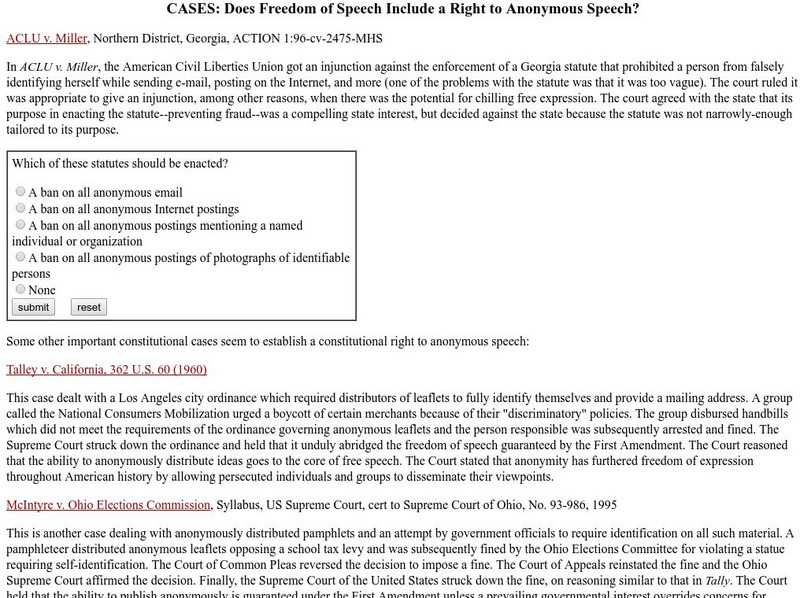Hi, what do you want to do?
Curated OER
Censorship In Fahrenheit 451
Tenth graders explore the concept of censorship through a reading of Fahrenheit 451. They discuss the issue and its relation to contemporary society. Students work in groups to debate the pros and cons of censorship in our society.
Curated OER
Fahrenheit 451: KWHL Strategy
Turn your readers into "examiners, critics, knowers, and imaginative creators," with a KWHL strategy designed for Fahrenheit 451. Individuals fill out a KWHL graphic organizer about censorship and then share responses with a group. The...
Curated OER
Cartoons for the Classroom: Censorship, Silencing an Anti-War Voice
In this primary source analysis worksheet, students analyze political cartoons with anti-war messages and respond to 5 talking point questions.
Curated OER
Hazelwood v. Kuhlmeier (1988)
Students explore the concept of student press rights. For this case study lesson, students read excerpts of Hazelwood v. Kuhlmeier. Students then complete the provided worksheet activities and determine whether they agree with the...
Curated OER
Overcoming Censorship Through Art
Young scholars create an art piece that expresses their opinions while circumventing hypothetical government restrictions in this lesson on art and government censorship. Emphasis is placed upon historical instances of censorship around...
Curated OER
A Picture is Worth How Many (unfiltered) Words?
Students explore Google search engine in and out of China, examine events surrounding confrontation at Tiananmen Square between Chinese forces and the Tank Man, and discuss how censorship affects what the media reports and what the...
Curated OER
Debate: Press Censorship
Students consider the responsibility of the media to present newsworthy items while still protecting national security during times of war. They take sides acting as politicians and newsmen and debate the merits of censorship of the media.
Curated OER
Rights And Responsibilities: Debating Free Speech, Responsibility And Censorship on Campus
Students weigh rights of students and others to free speech versus the responsibilities that come with those rights.
Curated OER
Overcoming Censorship Through Art
Students examine and discuss government-imposed censorship of art and artists' methods for counteracting censorship. They view censored artwork, write a persuasive essay, and create an art piece.
Curated OER
Defending Great Literature
Students defend Mark Twain and the study of The Adventures of Huckleberry Finn using persuasive techniques, appropriate word choice, and correct letter format, in response to a fictional letter by an upset parent.
Curated OER
Censorship in the Classroom: Understanding Controversial Issues
Students examine propaganda and media bias and explore a variety of banned and challenged books. Following this, students choose a side of the censorship issue and support their position by developing an ad campaign about the banned book...
Curated OER
Keeping It Quiet
Students consider ways in which countries use censorship to control information. They examine China's recent abridgement of a politician's speech and consider China's recent history with other nations to better explain why censorship is...
Curated OER
Freedom of Hate Speech?
Students, using a New York Times article as a springboard for discussion, investigate and debate the complex issues of First Amendments Rights and censorship for Hate Groups using Websites for propaganda.
Curated OER
Editorial Cartoon: Censorship
Students explore the concept of juxtaposition. For this editorial cartoon lesson, students analyze an editorial cartoon techniques to develop an understanding of juxtaposition and symbolism used in the cartoons.
Curated OER
The Impact of Hazelwood on School Publications
Ninth graders explore the Supreme Court Case Hazelwood School District v. Kuhlmeier. In this American Government lesson, 9th graders research the recent history of censorship and how the courts have been involved in either...
Curated OER
Censorship in America
Learners follow resource links to study the history of art censorship in the US. They study the work of the FCC and the Hip-Hop 4 Peace campaign.
Curated OER
Fahrenheit 451
Students agree on a definition of censorship and then discuss incidents of censorship with which they are familiar. They might consider incidents in present-day America, elsewhere in the world, and in the past. Bradbury's novel serves as...
Curated OER
Heavy: The Story of Metal (Part 2)
Students discuss censorship of music and other art forms. Students create their own list of criteria for acceptable music. Students write a list of their own "Filthy fifteen" based on their criteria for acceptable music.
Curated OER
Children's Media and Censorship
Students examine the point of censorship when dealing with Students. They explore essays by Stephen King.
Curated OER
Why Burn Books?
Students identify the role of free speech in the selection of library books. They choose one banned book to read and evaluate the reason for its censorship. They create an argument for or against the selection of the book.
Harvard University
Harvard Law: Freedom of Speech and Anonymous Speech
This site from Cyber Harvard Law offers summaries of three different Supreme Court cases which address the limits of free speech. Includes interactive opinion, multiple-choice questions. Links to the written opinions of the Court for...
PBS
Pbs Learning Media: Censorship
In this Wide Angle video, the people behind Kalam Nawaem, or "Sweet Talk," a popular Arab television, discuss how they must carefully choose their topics and tone to not only increase audience interest, but to keep their program on the air.
University of Arizona
International Studies Association: Mobilizing Public Support for War
A scholarly look at the use of propaganda to influence American support for World War I once the country entered the fray. Read about the Committee on Public Information, examples of harassment of those not deemed sufficiently patriotic,...
Reporters Committee for Freedom of the Press
Rcfp: State of Ohio, Ex. Rel. (Amicus Brief)
A "friend of the court" document in which the Reporters Committee for Freedom of the Press explains why it believes that The Columbus Dispatch newspaper had the right to access government information for possible publication.


























